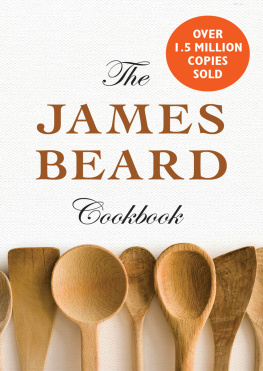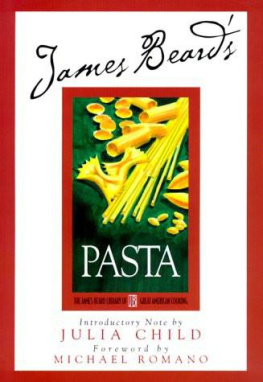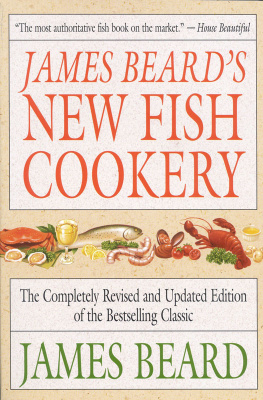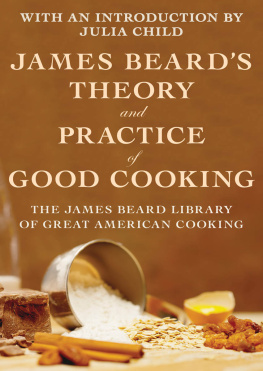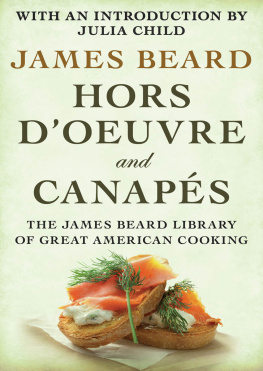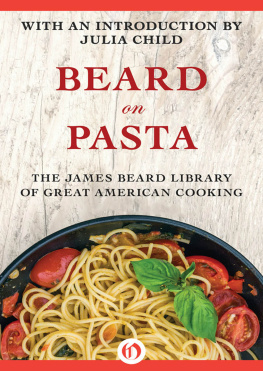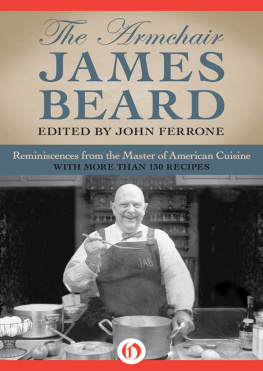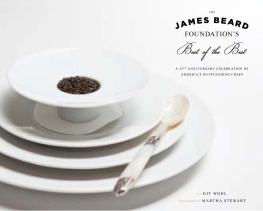James Beard
Beard on Food

Other books by James Beard

Hors d'Oeuvre and Canapes
Cook It Outdoors
Fowl and Game Cookery
The Fireside Cookbook
Paris Cuisine
(with Alexander Watt)
James Beard's New Fish Cookery
How to Eat Better for Less Money
(with Sam Aaron)
The Complete Book of Outdoor Cookery
(with Helen Evans Brown)
The James Beard Cookbook
James Beard's Treasury of Outdoor Cooking
Delights and Prejudices
James Beard's Menus for Entertaining
How to Eat (& Drink) Your Way Through
a French (or Italian) Menu
James Beard's American Cookery
James Beard's Theory & Practice of Good Cooking
The New James Beard
Beard on Birds
Beard on Pasta
James Beard's Simple Foods
Love and Kisses and a Halo of Truffles:
Letters to Helen Evans Brown
The Armchair James Beard
James Beard
Beard on Food
The Best Recipes and Kitchen Wisdom
from the Dean of American Cooking

Assisted by JosWilson
Illustrations by Karl Stuecklen
B L O O M S B U R Y
Copyright 1974 by James Beard
Illustrations Copyright 1977, 1983 by Karl W. Stuecklen
Introductory Note Copyright 1999 by Julia Child
Foreword Copyright 2007 by Mark Bittman
Update Copyright 2007 by Mitchell Davis
All rights reserved. No part of this book may be used or reproduced in any manner whatsoever without written permission from the publisher except in the case of brief quotations embodied in critical articles or reviews. For information address Bloomsbury USA, 175 Fifth Avenue, New York, NY 10010.
Published by Bloomsbury USA, New York
Distributed to the trade by Holtzbrinck Publishers
All papers used by Bloomsbury USA are natural, recyclable products made from wood grown in well-managed forests. The manufacturing processes conform to the environmental regulations of the country of origin.
LIBRARY OF CONGRESS CATALOGING-IN-PUBLICATION DATA HAS BEEN APPLIED FOR..
eISBN: 978-1-59691-715-6
Originally published in the U.S. by Knopf in 1974
Reissued by Running Press, a division of Perseus, in 2000
This edition published in 2007 by Bloomsbury USA
10 9 8 7 6 5 4 3 2 1
Printed in the United States of America by Quebecor World Taunton
Editor's Note (for pages 5, 236-237, and 291):
Cooks should be warned that there is some risk in eating raw or undercooked egg yolks and ground meat. The USDA goes so far as to say that all ground beef should be cooked to an internal temperature of 160F, which obviously is not possible in recipes calling for raw meat.
Contents

I t is wonderful for all of us who treasure James Beard to know that his works are being kept alive for everyone to enjoy. What a pleasure for those of us who knew Jim to read him again, and what a treasure and happy discovery for new generations who will now know him. He reads just as he talked, and to read him is like being with him, with all his warmth, humor, and wisdom.
Beard appeared on the American culinary scene in 1940, with his first book, Hors d'Oeuvre and Canaps, which is still in print more than fifty years later. Born in Portland, Oregon at the beginning of this century, he came from a food-loving background and started his own catering business after moving to New York in 1938. He soon began teaching, lecturing, giving culinary demonstrations, writing articles and more books (eventually twenty in all). Through the years he gradually became not only the leading culinary figure in the country, but "The Dean of American Cuisine." He remains with us as a treasured authority, and the James Beard Foundation, housed in his own home on West 12th Street in New York, keeps his image and his love of good food very much alive.
Beard was the quintessential American cook. Well-educated and well-traveled during his eighty-two years, he was familiar with many cuisines but he remained fundamentally American. He was a big man, over six feet tall, with a big belly, and huge hands. An endearing and always lively teacher, he loved people, loved his work, loved gossip, loved to eat, loved a good time.
I always remember him for his generosity toward others in the profession. For instance, when my French colleague, Simone Beck, came to New York for the publication of our first book, my husband and I knew no one at all in the food business, since we had been living abroad for fifteen years. Nobody had ever heard of us, but our book fortunately got a most complimentary review from Craig Claiborne in the New York Times. Although we had never met him before, it was Jim who greeted us warmly and introduced us to the New York food scene and its personalities. He wanted friends to meet friends, and he literally knew "everyone who was anyone" in the business. He was not only generous in bringing them together, but eager that they know each other. It was he who introduced us to the late Joe Baum of the then-famous Restaurant Associates and The Four Seasons, among other famous restaurants. He presented us to Jacques Pepin, at that time a young chef from France who was just making his way in New York, and to Elizabeth David, England's doyenne of food writers, as well as to many others.
It was not only that he knew everyone, he was also a living encyclopedia of culinary lore and history, and generous about sharing his knowledge. So often when I needed to know something about grains, for instance, I would call him and if the information was not right in his head, he would call back in a few minutes either with the answer or a source. This capability and memory served him well in his books and articles, as well as in conversation and in public interviews.
James A. Beard was an American treasure, and his books remain the American classics that deserve an honored place on the shelves of everyone who loves food.
Julia Child
April I, 1999
Though I never met him, James Beard taught me how to cook, andmore importanthow to think intelligently about cooking. In the late sixties and early seventies there was neither the culture nor the community of nonprofessional food lovers that now exists. Even professionals had a difficult time of it; there were few cooking schools, and most training was on-the-job. Most of us learned how to cook from our mothersor from cookbooks.
My mother taught me a few things, as did my grandmother. But cooking became serious for me when, as a senior in college, I fell in with a bunch of women who were avid cooks. These women (one of whom would later become my wife) relied on books by Craig Claiborne and Paula Peck. Within a year or two, completely enamored, I had bought my first cook-books: The Joy of Cooking and Julia Child's Mastering the Art of French Cooking. But it wasn't until the mid-seventies that I discovered James Beard, a literate, candid, forward-thinking, life-loving treasure.
Other people gave you recipes, sometimes detailed (Ms. Child), sometimes spare and functional (Mr. Claiborne). James Beard gave you logic, emotion, history, and consideration. He gave you confidence, and he let you relax. In a time when serious cooking meant French cooking, Beard was quintessentially American, a westerner whose mother ran a boardinghouse, a man who grew up with hotcakes and salmon and meatloaf in his blood. A man who was born a hundred years ago on the other side of the country, in a city, Portland, that at the time was every bit as cosmopolitan as, say, Allegheny PA.
Next page


